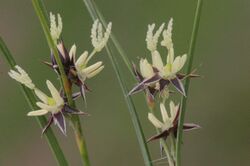Biology:Oreojuncus trifidus
| Oreojuncus trifidus | |
|---|---|

| |
| Scientific classification | |
| Kingdom: | Plantae |
| Clade: | Tracheophytes |
| Clade: | Angiosperms |
| Clade: | Monocots |
| Clade: | Commelinids |
| Order: | Poales |
| Family: | Juncaceae |
| Genus: | Oreojuncus |
| Species: | O. trifidus
|
| Binomial name | |
| Oreojuncus trifidus L. Záv.Drábk. & Kirschner
| |
| Synonyms[1] | |
| |
Oreojuncus trifidus is a species of rush known by the common names highland rush[2] and three-leaved rush.[3] It is native to the Northern Hemisphere, where it is an arctic/montane species with an amphi-atlantic distribution.[4]:46
Description
Oreojuncus trifidus is a perennial herb with tufted stems up to 40 centimeters long, growing erect or drooping. There are a few grasslike leaf blades measuring up to 12 centimeters long. The inflorescence holds one to four flowers with brown tepals and six stamens. The fruit is a capsule a few millimeters long.[5][6] The plant reproduces sexually with its flowering structures and vegetatively via its rhizome, when it may form colonies.[7]
Habitat
This species grows in a number of habitat types, especially in alpine environments. It can be found in talus, on cliffs and ledges, fellfields, tundra, and meadows. It grows in a wide variety of heath ecosystems. The soils may be dry to moist, calcareous, and acidic.[7] They may be gravelly, sandy, and rich in iron. The plant is known as a pioneer on ski slopes and roadsides.[5] It may grow alongside many types of mosses and lichens.[7]
Distribution
Oreojuncus trifidus is an amphi-atlantic plant,[4] native to northern and eastern Canada, including the Canadian Arctic Archipelago and other low Arctic regions, the northeastern United States, Greenland, Iceland, Scandinavia, northern Britain, and northern Asia.[5] It also occurs in the high mountains of southern Europe.[citation needed] While not rare in general, the plant faces threats in some locations. Some populations in the Adirondacks are harmed by trampling by hikers.[8] Rush habitat on Camel's Hump and Mount Marcy also suffers from trampling disturbance.[7] Rush-dominated heath in the Cairngorms is also potentially threatened by trampling.[9]
References
- ↑ "Oreojuncus trifidus (L.) Záv.Drábk. & Kirschner". Board of Trustees of the Royal Botanic Gardens, Kew. 2017. https://powo.science.kew.org/taxon/urn:lsid:ipni.org:names:77135599-1.
- ↑ "Juncus trifidus". Natural Resources Conservation Service PLANTS Database. USDA. https://plants.usda.gov/core/profile?symbol=JUTR2. Retrieved 22 January 2016.
- ↑ (xls) BSBI List 2007, Botanical Society of Britain and Ireland, https://bsbi.org/download/3542/, retrieved 2014-10-17
- ↑ 4.0 4.1 Hultén, Eric (1958). The Amphi-Atlantic Plants and their Phytogeographical Connections. Stockholm, Sweden: Almqvist and Wiksell.
- ↑ 5.0 5.1 5.2 Aiken, S.G., et al. 2007. Flora of the Canadian Arctic Archipelago: Descriptions, Illustrations, Identification, and Information Retrieval. NRC Research Press, National Research Council of Canada, Ottawa.
- ↑ Juncus trifidus. Flora of North America.
- ↑ 7.0 7.1 7.2 7.3 Schori, M. Conservation Assessment for Highland Rush (Juncus trifidus) L. USDA Forest Service, Eastern Region. May 6, 2004.
- ↑ Juncus trifidus. New York Natural Heritage Program.
- ↑ Pryor, P. J. 1985. The effects of disturbance on open Juncus trifidus health in the Cairngorm mountains, Scotland. In: The ecological impacts of outdoor recreation on mountain areas in Europe and North America. RERG Report, Recreation Ecology Research Group, UK. No. 9 53-62.
Wikidata ☰ {{{from}}} entry
 |

